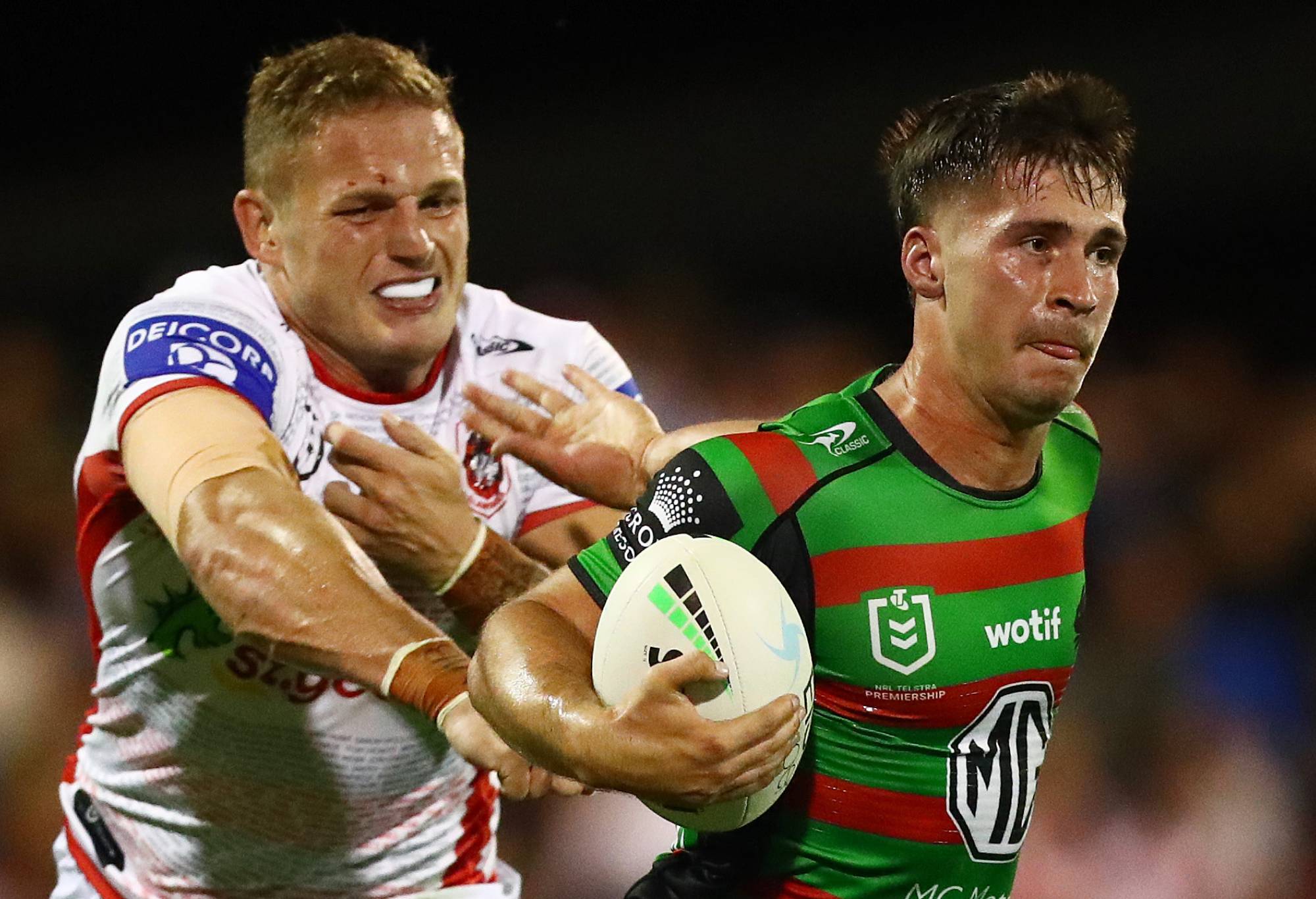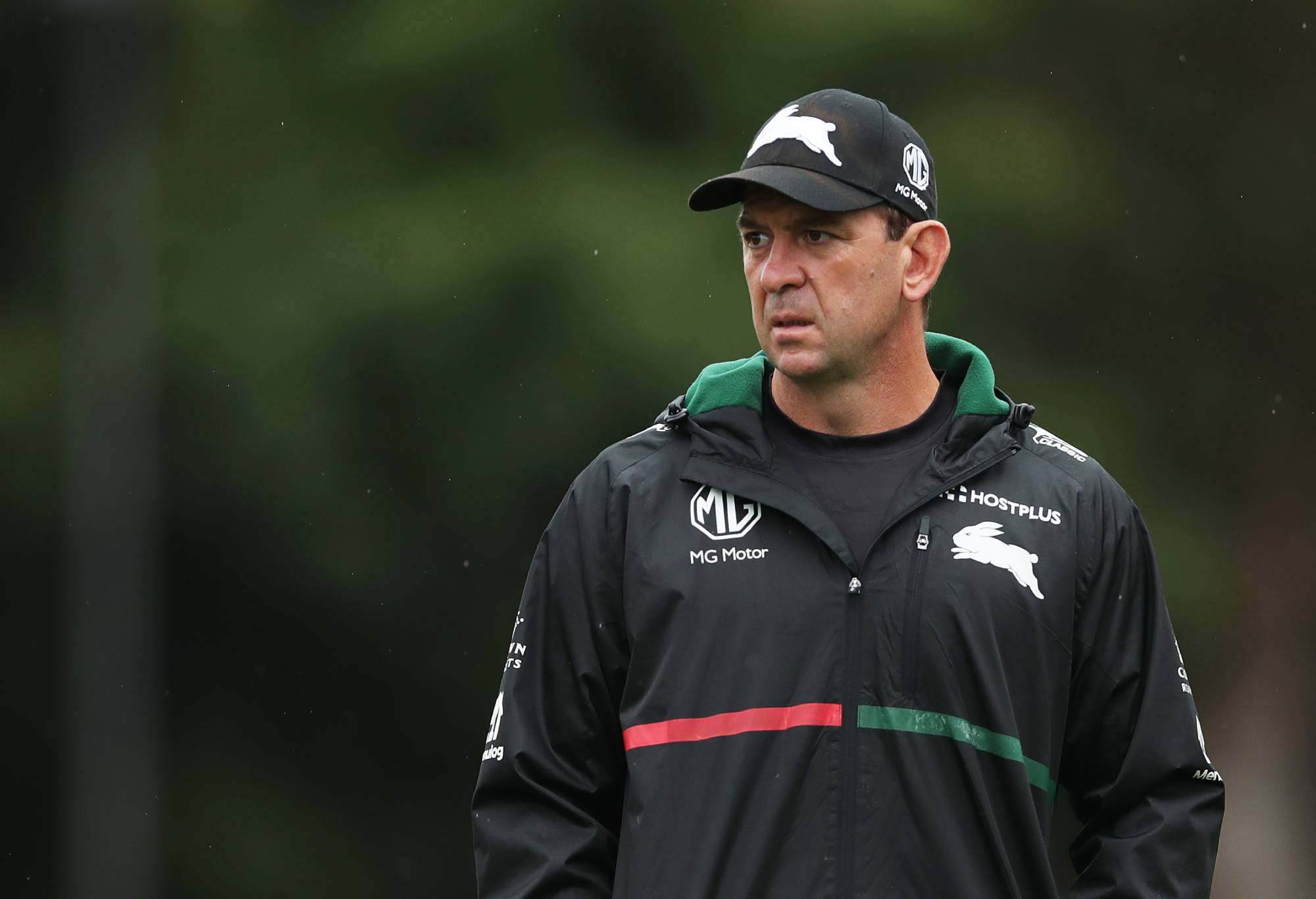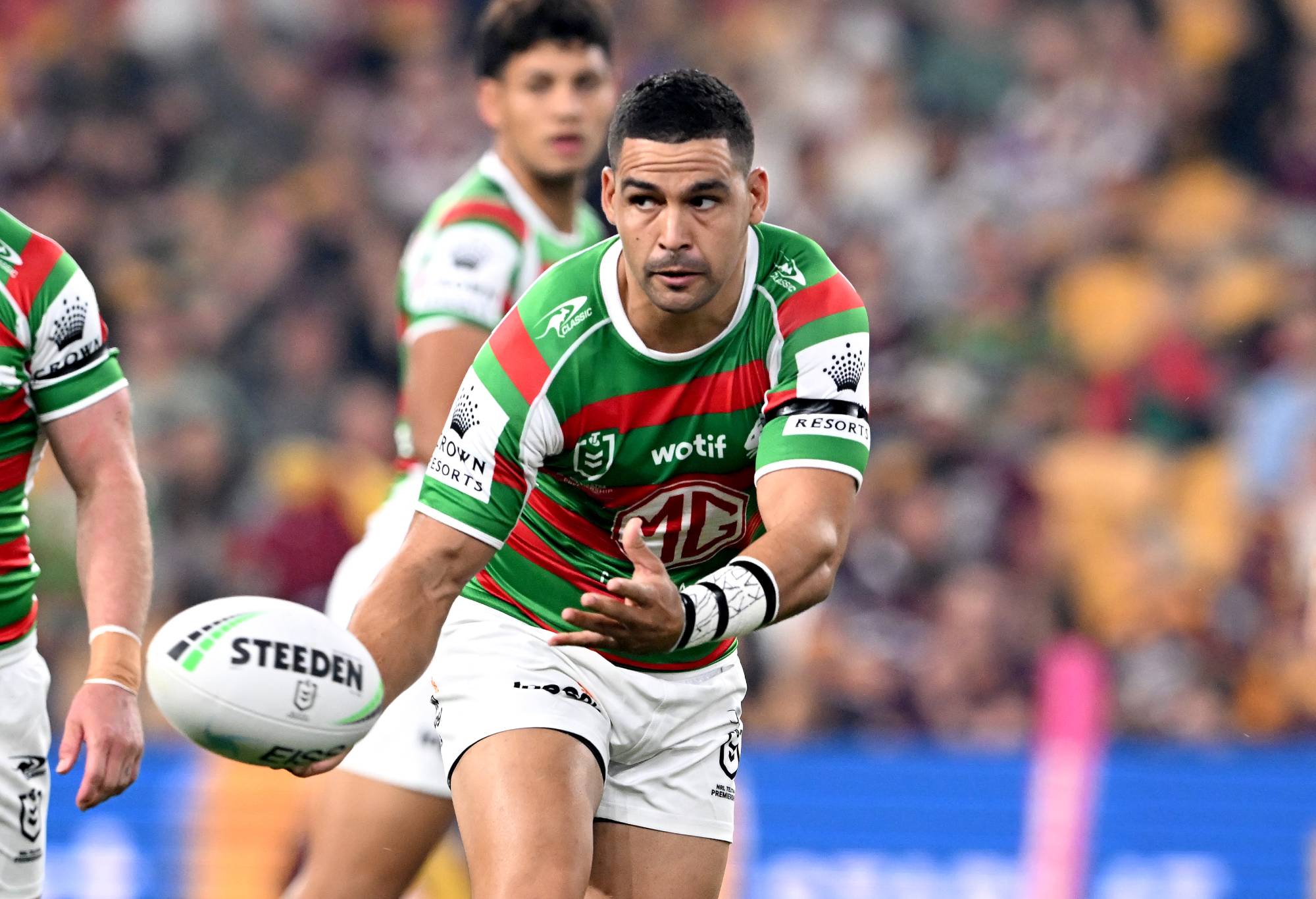
It’s a weird old game, rugby league. It is a results-based business a phrase we’re inundated with whenever a coach’s position is discussed, a results business. Undeniably, that is true.
But across a 25-round season, the results tend to reflect the underlying stats and things like form and luck become less prevalent. Over a series of such seasons, even more so. Suddenly results look very short term.
This is something worth considering when thinking about the deal that led to Adam Reynolds leaving South Sydney for Brisbane and the succession plan that has resulted in Lachlan Ilias taking over the No.7 jersey at the Bunnies.
Given the Broncos have twice beaten Souths this year – once in which Reynolds was the clear standout player on the field – and are now on a five-game unbeaten streak, it is quite easy to see the narrative where it was a bad idea to let Reynolds go.
Compounding this is that Souths, who made the Grand Final last year, are now behind the Broncos, who finished 14th. It looks like a major turnaround with one easy thing to point towards that explains why it has happened.
To do so, however, would not only misread what has happened this year, but also what is set to happen in the next few years.
Simply put: Reynolds is the man the Broncos needed, right now, but he is absolutely not the man Souths need, not now and definitely not going forward.
We can focus on what Souths need in a bit, but let’s talk first about the Broncos. It’s hard to think of anyone else that they could have signed who would have been better for the role they required.
Brisbane are in a unique roster position because they have a crop of players who are reaching a golden period in their NRL careers.
Kotoni Staggs and Payne Haas debuted in 2018, plus Herbie Farnworth, Pat Carrigan and Thomas Flegler in 2019, making them all in the key developmental period between 50 and 75 NRL games where players are established first-graders rather than prospects.
In 2020 and 2021, when those five players have played the bulk of their NRL careers, the Broncos have won just 22% of games. They’ve also conceded an average of 27.3 points per game.
What the Broncos have needed more than anything has been defensive assistance, and if you speak to Kevin Walters – as I regularly do at press conferences – that’s what he’ll tell you Reynolds has brought.
Not his chip and chase tries, or his playmaking, but his defence. More importantly, his defensive kicking.
“For the last few years, we haven’t been able to finish our sets off the way that we like to,” said Walters at the presser after the crushing 34-0 Magic Round defeat of Manly.
“He’s one of the best kickers in the game and that helps your defence in terms of where and how you turn the ball over.”

Lachlan Ilias during the Charity Shield. (Photo by Mark Metcalfe/Getty Images)
He’s absolutely right. Reynolds is a master at kicking, but specifically long kicking. Brisbane aren’t great at making metres: if you watch closely, they tend to do well on plays one and two through their big bodies out wide, but Payne Haas aside, their central go-forward is not brilliant.
Haas tops the forward average metres count, though he takes two more runs per game than anyone else in the league on average and on metres per run, he’s only 10th for props.
Pat Carrigan is seventh on the average metres list, but it’s a long way down after that to Corey Jensen (36th), Flegler (44th) and Keenan Palasia (46th).
What that means in practical terms is it is incumbent on Reynolds to kick the Broncos out of trouble, and he does that exceptionally well: he takes the most long kicks in the league and kicks for the longest distance.
In the other metrics … less so. Reynolds is fifth for try assists, eighth for line break assists and way, way down for try contributions (more on which later). A lot of this is attributable to his seniority in the team and his position as the dominant playmaker.
He’s already had three five-eighth partners this year, and none of them have been that great, plus a new fullback and several hookers. Reynolds is doing absolutely everything, and really, that’s what Brisbane needed.
“The inclusion of some senior players (has helped) with Adam Reynolds, Kurt Capewell and Ryan James, and the attitude and the steel of the players to change what is happening,” said Walters after that Manly game.
“You can talk about things and how you’re going to try to do them, but the actual changes come from within and that’s been the big turnaround for us. It’s great to see.”
Again, he’s absolutely right. With their younger cohort coming into what you might call ‘primes’ having won one in five matches in their NRL careers, what Brisbane required – emotionally, for want of a better word – was a proven winner, a senior leader and someone to hold their hands.
In Reynolds, and Kurt Capewell, fresh off the back of a premiership with Penrith, they go that. All power to them.
Rabbits in a different phase
Let’s not confuse that with South Sydney, however. They are a different team in an entirely different phase. Souths are Brisbane in 2019, except they are still a good side and are integrating their young players into it.
The Bunnies are solidly midtable in 2022, which is a bit of a fall from being in the Grand Final, but understandable: they lost their coach and replaced him with an internally-promoted rookie, Jason Demetriou, as well as their captain in Reynolds.
On top of that, they then lost their best player, Latrell Mitchell, to injury and have now lost their captain, Cameron Murray, to another injury. Yet the South Sydney 2022 campaign still shows more than a few green (or should that be myrtle) shoots.

Jason Demetriou. (Photo by Matt King/Getty Images)
Souths are hugely underperforming their underlying data this year, which is usually a sign that results are set to track upwards in the near future.
For what it’s worth, and to double down on the Reynolds-as-defensive-signing angle, Souths have actually scored more points than the Broncos despite being two wins worse off.
They have faced a double threat of a hard draw – Melbourne and Penrith away in the first month and the Roosters at home – and a chronically poor completion rate.
There’s an opus in there about the usefulness of completion rates as a stat, but in South Sydney’s case, there is some utility: they drop the ball more than any team, which is bad, obviously.
Diving deeper, however, and another pattern emerges. I can’t take credit for this work, as the ever-excellent Rugby League Eye Test beat me to it, but Souths have a tendency to make errors early and therefore leave themselves with a lot to do in order to win. As they chance games, the desperation grows, the errors compound and you know the rest.
Last weekend was a perfect example: they completed at 63% before the break and found themselves 24-0 down, and even though they did improve in the second half, the Bunnies simply had to try too hard to create points that they invited several interceptions.
I have posited in these pages before that only a 3% rise in completion rates would see Souths blow teams off the park: lo and behold, they completed at 86% in the first half against the Warriors at Magic and went to the sheds 26-6 up. Then they completed at 65% in the second and nearly lost.

(Photo by Cameron Spencer/Getty Images)
League Eye Test’s latest work also pulls out the more than interesting stat that Souths pile on the most points while leading, while also conceding the least while leading, suggesting that when they’re on, they’re on, and when they’re off, well, they’re off.
Souths have lost every game they have trailed at the break and won every game where they have led.
The underlying data suggests that a serious reversion to the statistical mean is well overdue for South Sydney, if and when they sort their completions out.
Their rate is currently 72%, the worst in the NRL, but if it were to edge up just a little bit it could make huge impact. The Roosters won two comps in the less free-flowing NRL of 2018 and 2019 with mid-70% completion rates.
The other building blocks are in already in place. Souths are third in the comp for line breaks and line engagements and fourth for supports and decoys, suggesting that when they do get the ball, they are trying to do something with it.
They have the fewest number of play-the-balls inside their own half, the most in the opposition’s 20 and also face the fewest play-the-balls inside their own 20, so field position clearly isn’t an issue either.
They also come out well in both net metres – that is, metres made v conceded, as pointed out here by Jason Oliver – and in net post-contact metres, heavily suggesting that they tend to do well in the battle of the forwards.
What we can glean from all of their stats is that South Sydney have no issue getting to the right end of the field, no issue winning in the middle and are quite good at manufacturing chances. They’re just awful at taking them.
Kicking on so important
A particularly telling stat is the kicking metres. The Broncos are top, of course, with Reynolds, and the Bunnies are bottom. But Souths have far less space to be kicking into – because they’re already where they need to be. They don’t need what Reynolds has, and Brisbane certainly do.
This is where the important differential in 2022 between Reynolds and his replacement, Ilias, comes in. Reynolds is the senior half who, as mentioned, has the dual goals of manipulating field position and leading the team around.
Ilias is the junior half – he’s only played 12 NRL games – with Cody Walker now doing the bulk of the kicking. Walker was previously a statistical monster for try assists, with the much vaunted 33 of them in the bullshit stats year of 2021, with a subset in line break assists, the stat for when you put someone through a hole.

Cody Walker (Getty Images)
In the previous Souths system, it was Reynolds who got the ball to Walker, who either ran, put someone over or fed the ball to Latrell Mitchell.
Now, with Ilias in the place of Reynolds and Mitchell injured and replaced by Blake Taaffe, the system has been substantially remodelled. But that isn’t to say that it isn’t working.
Ilias has six line break assists – two behind Reynolds – and four try assists, well below his predecessor on 11.
But Walker, now the dominant half, is on a massive 11 line break assists and eight try assists, suggesting that the distribution has changed. No other Broncos player is close to what Reynolds is posting, because everything runs through him.
The young halfback is also currently fourth in the NRL for the somewhat strange stat of ‘try contributions’. Try contributions is a contrived stat for Supercoach players, brought in to replace the ‘last touch assist’ stat and instead reward contributions further back up the chain of play.
My heavy suspicion is that it is generated by the underlying ‘pre-assist’ data point that clubs (and Newscorp) have access to but I don’t. Pre-assists are the pass before the pass, the crucial movement that allows someone else to work themselves into space. I suspect Ilias ranks very highly in this regard.
Packing a punch
I think this because I’ve watched a lot of South Sydney in person and thought that Ilias was incredibly good as what I had been calling ‘packing’.
Packing is a soccer stat, a measure of how many players you take out of the game via your actions: think of a defender who dribbles out from the back, or a midfielder with an incisive through ball, bypassing a number of players that they have ‘packed’.
Ilias is superb at the rugby league equivalent of this because he takes the ball to the line and draws contact, before finding someone (invariably Walker) out the back to take advantage of the space created.
The first try against the Warriors two rounds ago was a perfect example: it was universally described as an excellent pass from Walker, but actually a great piece of packing from Ilias, who takes three defenders out of play and leave Walker with what is, in the end, quite a simple execution.
If you take the raw line break assist and try assist numbers for Reynolds, Walker, Ilias and whoever is standing next to Reynolds for the Broncos, it is clear that Souths have more than replaced the attacking contribution that their veteran half created.
This is where the long-term aspect comes in. Reynolds, as everyone will know, chose to leave Souths for Brisbane because they offered him three years while the Bunnies only offered one.
This all looks very silly in 2022, but for the reasons discussed above, and those to be discussed now, it isn’t at all. Reynolds is 31 and now has a contract until he is 34, but has a chequered injury history. He’s not a guy to build the next Grand Final team around, at least not for South Sydney.
South Sydney know their development pathways pretty well, and knew that they were about to come into some gold. They won the 2019 Jersey Flegg Grand Final with Ilias at five-eighth, Taaffe at halfback and Peter Mamouzelos at hooker, all of whom they just extended.
Taaffe is deputising for the injured Mitchell at fullback but you can imagine that he will be slated in to take the five eighth job when Walker, now 32 and off contract at the end of next season, leaves or is offered a similar deal to what Reynolds got.
The situation at the Broncos, where five players hit the 50-75 game mark at the same time, would likely occur for Souths in 2024, but that only happens if you start to blood guys now.
When Ilias and Taaffe hit that mark, you can probably assume that Mamouzelos will not be far behind them, while others like Davvy Moale and Jaxson Paulo are also already in the NRL.
The Bunnies will also have Mitchell, Murray, Campbell Graham, Jai Arrow, Keaon Koloamatangi, Liam Knight and Junior Tatola well into their primes, and will be able to extend them because of the cash saved on Reynolds and, in all likelihood, Walker next year.
Salary capped sports are all about efficiency and getting the right guys for the right price. Souths are already paying Ilias far less than Reynolds was on to create basically the same attacking output, and he will only get better.
If they had extended Reynolds, even for one year, that would have been another year of Ilias in NSW Cup or – worse – looking elsewhere.
Souths have Taaffe on the same route, getting top grade experience because of injury that will stand him in good stead next year, the year after and the year after that.
It’s rare in rugby league that we look at things as being mutually beneficial. This might be one of the cases where that has happened: Souths were right to let Reynolds go, and Brisbane were right to pick him up.